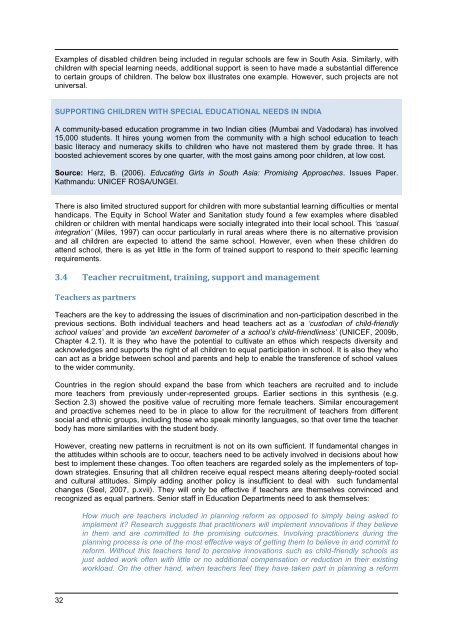DISPARITIES IN EDUCATION IN SOUTH ASIA A Resource Tool Kit
DISPARITIES IN EDUCATION IN SOUTH ASIA A Resource Tool Kit
DISPARITIES IN EDUCATION IN SOUTH ASIA A Resource Tool Kit
You also want an ePaper? Increase the reach of your titles
YUMPU automatically turns print PDFs into web optimized ePapers that Google loves.
Examples of disabled children being included in regular schools are few in South Asia. Similarly, with<br />
children with special learning needs, additional support is seen to have made a substantial difference<br />
to certain groups of children. The below box illustrates one example. However, such projects are not<br />
universal.<br />
SUPPORT<strong>IN</strong>G CHILDREN WITH SPECIAL <strong>EDUCATION</strong>AL NEEDS <strong>IN</strong> <strong>IN</strong>DIA<br />
A community-based education programme in two Indian cities (Mumbai and Vadodara) has involved<br />
15,000 students. It hires young women from the community with a high school education to teach<br />
basic literacy and numeracy skills to children who have not mastered them by grade three. It has<br />
boosted achievement scores by one quarter, with the most gains among poor children, at low cost.<br />
Source: Herz, B. (2006). Educating Girls in South Asia: Promising Approaches. Issues Paper.<br />
Kathmandu: UNICEF ROSA/UNGEI.<br />
There is also limited structured support for children with more substantial learning difficulties or mental<br />
handicaps. The Equity in School Water and Sanitation study found a few examples where disabled<br />
children or children with mental handicaps were socially integrated into their local school. This „casual<br />
integration‟ (Miles, 1997) can occur particularly in rural areas where there is no alternative provision<br />
and all children are expected to attend the same school. However, even when these children do<br />
attend school, there is as yet little in the form of trained support to respond to their specific learning<br />
requirements.<br />
3.4 Teacher recruitment, training, support and management<br />
Teachers as partners<br />
Teachers are the key to addressing the issues of discrimination and non-participation described in the<br />
previous sections. Both individual teachers and head teachers act as a „custodian of child-friendly<br />
school values‟ and provide „an excellent barometer of a school‟s child-friendliness‟ (UNICEF, 2009b,<br />
Chapter 4.2.1). It is they who have the potential to cultivate an ethos which respects diversity and<br />
acknowledges and supports the right of all children to equal participation in school. It is also they who<br />
can act as a bridge between school and parents and help to enable the transference of school values<br />
to the wider community.<br />
Countries in the region should expand the base from which teachers are recruited and to include<br />
more teachers from previously under-represented groups. Earlier sections in this synthesis (e.g.<br />
Section 2.3) showed the positive value of recruiting more female teachers. Similar encouragement<br />
and proactive schemes need to be in place to allow for the recruitment of teachers from different<br />
social and ethnic groups, including those who speak minority languages, so that over time the teacher<br />
body has more similarities with the student body.<br />
However, creating new patterns in recruitment is not on its own sufficient. If fundamental changes in<br />
the attitudes within schools are to occur, teachers need to be actively involved in decisions about how<br />
best to implement these changes. Too often teachers are regarded solely as the implementers of topdown<br />
strategies. Ensuring that all children receive equal respect means altering deeply-rooted social<br />
and cultural attitudes. Simply adding another policy is insufficient to deal with such fundamental<br />
changes (Seel, 2007, p.xvii). They will only be effective if teachers are themselves convinced and<br />
recognized as equal partners. Senior staff in Education Departments need to ask themselves:<br />
How much are teachers included in planning reform as opposed to simply being asked to<br />
implement it? Research suggests that practitioners will implement innovations if they believe<br />
in them and are committed to the promising outcomes. Involving practitioners during the<br />
planning process is one of the most effective ways of getting them to believe in and commit to<br />
reform. Without this teachers tend to perceive innovations such as child-friendly schools as<br />
just added work often with little or no additional compensation or reduction in their existing<br />
workload. On the other hand, when teachers feel they have taken part in planning a reform<br />
32
















